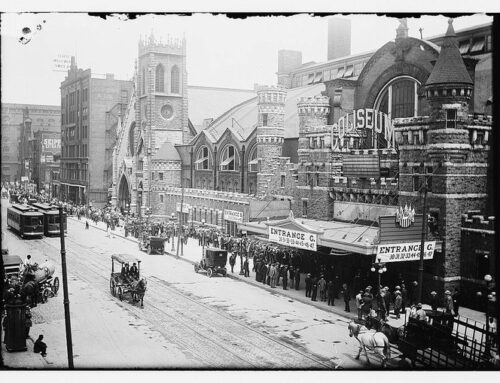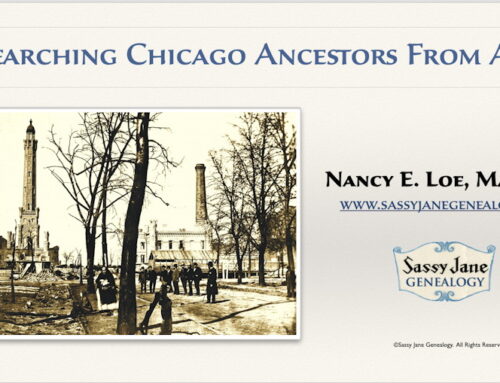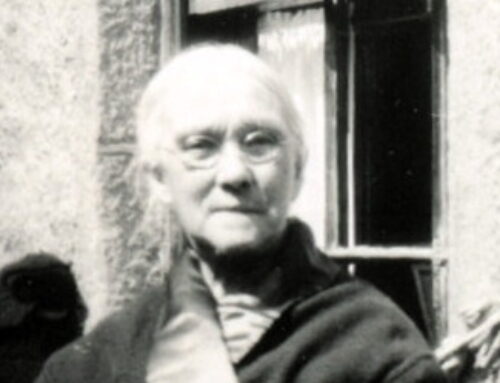This summer I’ve been finding Scottish Ancestors at Dunnottar. On my second trip of eight planned to visit the ancestral villages of my immigrant great-grandparents, I visited Dunnottar Castle. Once a 13th-century Scottish hilltop fortress, by the 15th century Dunnottar was a Highland castle. Today lies in ruins.
 The Ancestors
The Ancestors
My great-great-great-great-great grandparents, Robert Moncurr and Anna Jerves, were born and married in the Dunnottar parish. Of course I made a beeline to Dunnottar Castle. But as a genealogist, I have no illusions that my family were nobility or even landholders.
Dunnottar, the Place
A Vision of Britain Through Time notes, “Dunnottar (anc. Dunfoither; Gael. dun-oitir, ‘fort of the low promontory ‘), a coast parish of Kincardineshire, containing the fishing village of Crawton and all the old town of Stonehaven. It is bounded NW and N by Fetteresso, E by the German Ocean, S by Kinneff, and SW by Arbuthnott and Glenbervie.”
The castle itself began as a medieval stronghold jutting off coast of Scotland. The guidebooks says it lies 160 feet (felt twice that when hiking up) above the North Sea, and about two miles south of Stonehaven.
The buildings that survive are largely of the 15th and 16th centuries, which is fine with me because that’s when I found my ancestors in the area.
Dunnottar Castle is a scheduled monument. Twelve structures are designated as listed buildings, including the chapel, an “oblong roofless ruin, dating late 16th century and incorporating mediaeval fragments,” It’s pleasing to know that when my ancestors were marring in 1761, this castle still had its roof.
 Dunnottar’s Place in History
Dunnottar’s Place in History
“Dunnottar has played a prominent role in the history of Scotland through to the 18th-century Jacobite risings because of its strategic location and defensive strength. Dunnottar is best known as the place where the Honours of Scotland, the Scottish crown jewels, were hidden from Oliver Cromwell‘s invading army in the 17th century. The property of the Keiths from the 14th century, and the seat of the Earl Marischal, Dunnottar declined after the last Earl forfeited his titles by taking part in the Jacobite rebellion of 1715.”
That’s all very impressive and it was wonderful to visit, but it was time to parse the difference between Dunnottar Castle and Dunnottar Parish.
The Records
Robert Moncurr was baptized in the parish of Dunnottar on 14 Jul 1737. (Scottish records of this era list the father and the male witnesses but not the woman who actually gave birth to the child.) Charles, his father, lived in Easterside, where the birth presumably took place.
ScotlandsPlaces notes that Easterside was “a small farm steading on the Estate of Dunnottar the property of Sir Patrick Keith Murray Baronet.” (I’m practically tugging my forelock on behalf of my ancestors reading that record.)
I next found Robert in his 1761 marriage record to my great-great-great-great-great grandmother, Anna Jerves. All I am able to discover about Anna is that she was:
1. in a very early witness protection program, or
2. landed in Dunnottar parish in a pre-pre-prequel of an intergalactic visit, or
3. spelling her name many different ways. I know nothing about her, but her marriage and the birth of her daughter Margaret.
Close reading of this record notes that they both living in Kinneff, “a roadside hamlet” where they posted their banns. The description of Dunnottar parish said it was bounded on the south by Kinneff. Robert was a whitefisher by occupation, which also fits.
The Results
So the most logical place my 5-g-grandparents were married was the Kinneff Old Kirk, This lovely kirk was first consecrated 5 August 1242. From 1651-1660, the Crown Jewels of Scotland were hidden in Kinneff Church from Cromwell and his marauders.
After the restoration of Charles II, the Scottish Crown Jewels were moved to Edinburgh Castle.
In 1737 the Kirk of Kinneff was described as “in such a state as that it is dangerous for people to assemble therein for divine worship” so the Presbytery of Fordoun “concluded to build a new Kirk upon ye same foundation.”
I’d like to think that my 5-greats hurled some cabers, or won a haggis-eating competition, or won the tartan-weaving competition visiting their neighbors at Dunnottar Castle.
The records peter out beyond Charles Moncurr, my 6-g grandfather, but perhaps they were in the area long enough to have actually worked and lived at Dunnottar Castle.
In the meantime, I’m just happy knowing where Robert and Anna really lived and raised their family. Going to Dunnottar gave me a feeling for the land, And I also gained an idea of what was not just possible, but logical, in the records I’ve found.
Heritage Trips
Stay tuned for more posts from my next stop in the Highlands. It’s full of Picts (or their stones), tartans, Clan Ross, sheep, dry-stone walls, rain, single-malt whiskey, and haggis (yep, I ate it twice). It also has the most lovely people (outside of Norway, of course). They actually seem to like Americans with Scots ancestors mucking about in their towns.








Your story and photos remind me a lot of a trip we took a few months ago to Carrickfergus, No. Ireland. One of my ancestors left the Mass. Bay Colony and died there in 1656. You did a great job telling the story and your photos really enhance the mood.
Thank you – very nice of you to say. And what an interesting genealogy to emigrate back to Ireland so early.
Marion, they do sound rugged! And thx, Diana. It really was helpful as well as fun.
What a fun trip back in time to old Scotland! This is a great example of how helpful it can be to go on location to an ancestor’s homeplace.
Through the stones to the Highlands! Really fun following along in your footsteps. My husband’s McClure family was from Isle of Skye, but had to move to Donegal. They were a rugged bunch who sailed to Philadelphia in 1730s-40s and walked, as a family, to Virginia to buy farmland.
Not while I’m working full-time! Maybe after I retire . . .
I enjoyed your trip back in time to stand where your ancestors stood. My Moore ancestors are from Scotland.
Thx, Liz. I think you can tell I was pretty excited to go on this trip. Are you planning at trip to Scotland about your ancestors?